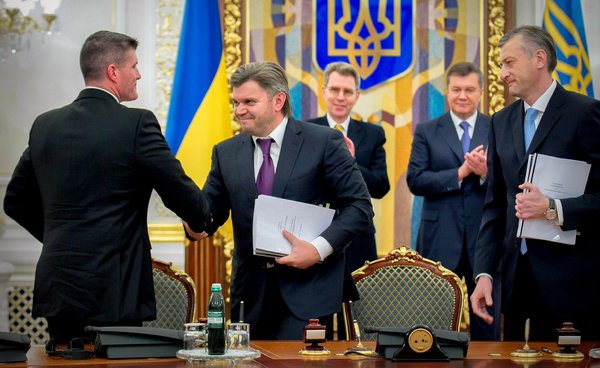
Ukraine Launching Major Gas Extraction Projects with Western Companies
Publication: Eurasia Daily Monitor Volume: 10 Issue: 201
By:

The Ukrainian government is launching major natural gas extraction projects in the country, as joint ventures with leading Western companies (Interfax-Ukraine, Ukrinform, November 5). At present, Ukraine depends on Russian gas imports for more than 60 percent of Ukraine’s total annual consumption (Bloomberg, November 7). The government’s goal is not simply to reduce Ukraine’s dependence on Russian gas, but—far more boldly—to eliminate that dependence entirely and achieve self-sufficiency by boosting gas extraction within the country.
The Ukrainian government is currently working with Chevron, ExxonMobil, and Royal Dutch Shell toward that goal. These projects are variously targeting shale gas, tight gas, and conventional gas, onshore and offshore on Ukrainian territory.
According to President Viktor Yanukovych’s statement, occasioned by the agreement just signed with Chevron (see below), the projects with Shell, ExxonMobil, and Chevron would enable Ukraine to become self-sufficient for gas supplies by 2020 (Presidential press release, November 5).
On November 5, Chevron and the Ukrainian government signed a production sharing agreement (PSA) to explore and develop the Olesska shale gas deposit, an acreage straddling the Ivano-Frankivsk and Lviv oblasts. Energy Minister Eduard Stavytsky and Chevron Exploration and Production Europe chief, Derek Magness, signed the agreement in Kyiv, witnessed by President Yanukovych and the United States’ ambassador to Ukraine, Geoffrey Pyatt.
Under the agreement, the Ukrainian state (represented by the Ministry of Energy and Nadra Ukrainy’s Nadra Olesska subsidiary) and Chevron shall each hold 50 percent of the project’s shares. Chevron shall make an initial $350 million investment in geological surveys and exploration drilling during the first three years of work on the project. If that phase is successful, the PSA’s lifetime can continue for up to 50 years, depending on the size of the shale gas deposit. The Ukrainian side anticipates investments of up to $10 billion for the project’s lifetime, and an extraction volume in the range of 5 billion cubic meters (bcm) to 10 bcm per year, once production reaches the plateau phase (Interfax-Ukraine, Ukrinform, November 5).
Ukraine’s agreement with Chevron is the latest in a series of project agreements of comparable significance. In September 2013, Shell and the Ukrainian government signed a PSA to explore and develop the Yuzivske gas deposit in the Donetsk oblast. That deposit is believed to contain shale gas as well as conventional gas. The PSA follows the pattern of 50 percent to 50 percent distribution of shares between the Ukrainian state (energy ministry with Nadra Ukrainy) and Shell in this case, for up to 50 years. Minister Stavytsky estimates the total investment value at $10 billion, and the plateau-phase production at 8 bcm per year. Shell has committed $500 million to the first stage of exploration, starting from 2014 with plans to drill some 15 exploration wells (Ukrinform, November 7).
In August 2013, a consortium of ExxonMobil and Shell signed an agreement of intentions with Ukraine’s Ministry of Energy to explore the Skyfska offshore gas deposits in the western Black Sea. The Ukrainian government chose this partnership instead of one with Russian Lukoil. Negotiations are intended to be completed by the end of 2013) (PRNewswires, November 5; Bloomberg, November 7).
Gas supplies sourced from liquefied natural gas (LNG) is also a scenario under consideration in Kyiv. The Ukrainian government proposes to draw up a Croatian-Hungarian-Ukrainian inter-governmental agreement to construct an LNG terminal on Croatia’s Adriatic coast and to inter-connect Croatia’s gas pipeline network with that of Ukraine via Hungary’s (Ukrinform, Interfax-Ukraine, November 6).
Some basic aspects of the gas extraction projects remain unclear or even unknowable at this preliminary stage. The size of reserves, extraction costs and the commerciality of the projects are yet to be determined. While Ukrainian officials seem confident enough to anticipate future production volumes, the three Western major companies involved are tight-lipped about reserves and potential production. After the early results of shale gas exploration in neighboring Poland turned disappointing, the general tone of debates on shale gas in Ukraine has become more circumspect. Local opposition to shale gas projects seems also possible in Ukraine, following local protests in Bulgaria and Romania that halted Chevron’s and other shale gas projects there. Whether hydraulic fracturing or “fracking” (method used to extract natural gas from shale rock formations) turns out to be more acceptable in Ukraine than elsewhere is also far from clear.
By striving to reduce dependence on Russian gas, and pursuing self-sufficiency, Ukraine aspires to: a) security of supplies (optimal when the supplies are sourced internally); b) diversification of suppliers (putting an end Russia’s quasi-monopoly); c) a competitive internal gas market in Ukraine (with multiple suppliers), leading to lower prices; and d) obtaining some negotiating counter-leverage vis-à-vis Russia (when Russia’s supply monopoly comes to an end).
The United States consistently supports Ukraine’s energy security goals. This provides at least one item of counter-evidence to the widespread perception of US disengagement from Europe’s East. The recently appointed Ambassador Pyatt builds on the legacy of his predecessor, Ambassador John Tefft, promoting US-Ukrainian joint projects in Ukraine’s energy sector.




